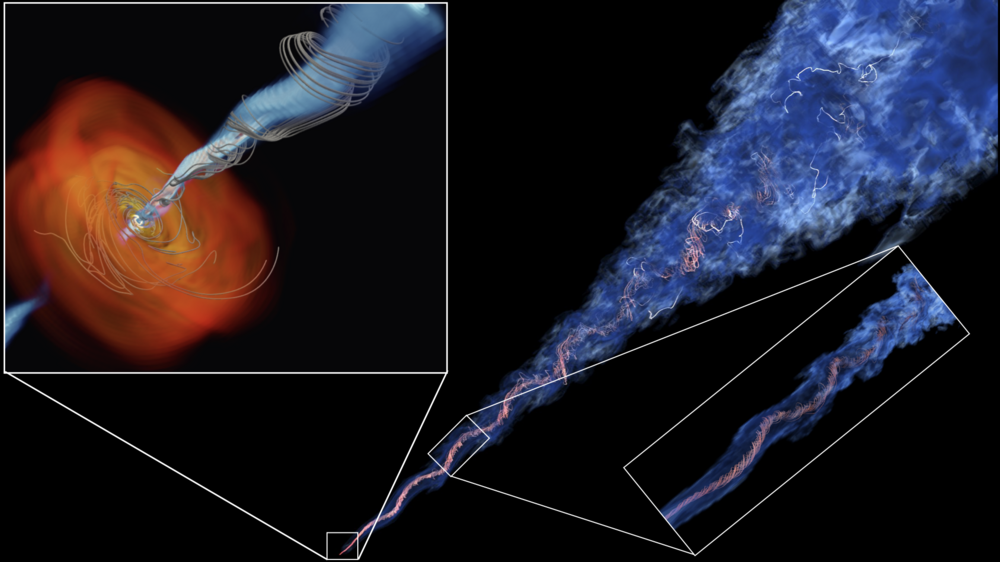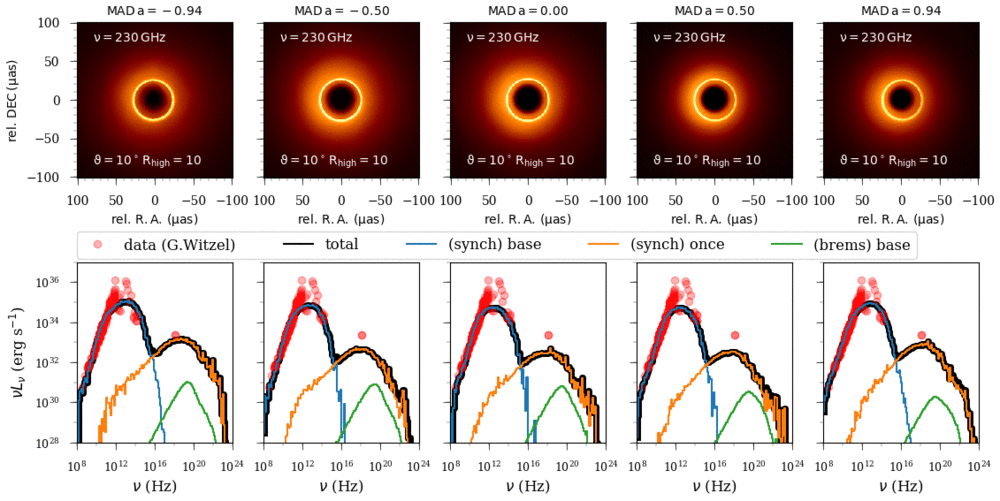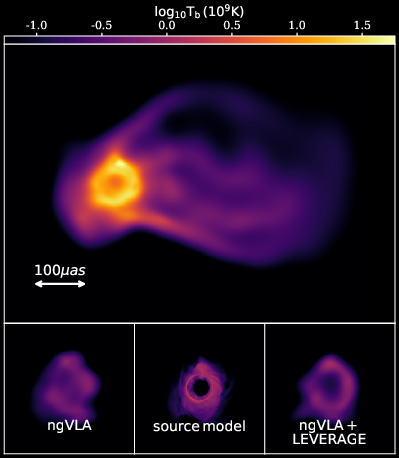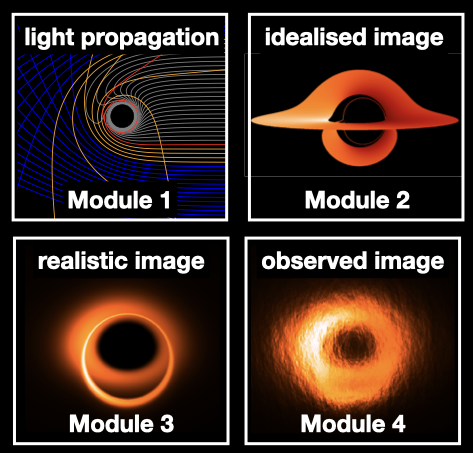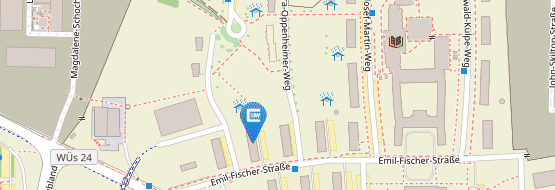AG Fromm
Computational Astrophysics
Dr. Christian M. Fromm
Black holes are among the most fascinating objects in the Universe and are characterised that not even light can escape their gravitational pull once crossing the event horizon. However, in the direct vicinity of supermassive black holes relativistic jets are launched. These jets propagate as collimated outflows up to millions of light years, emitting radiation across the entire electromagnetic spectrum while accelerating particles to highest energies. Our research group is focused on providing answers to the pending questions of black hole and jet physics among them:
- How are relativistic jets launched?
- Can relativistic jets extract energy from black holes?
- How are particles accelerate to highest energies?
- Which physical mechansims can generate high energy flares?
- Is there a common jet launching process across the black hole mass range?
In order to investigate these question we use a combination of state-of-the art numerical simulations and observations across the electromagnetic spectrum and beyond. Among the observations, Very Long Baseline Inferometric (VLBI) provide the unique capability to resolve and track structural variations within the accretion flow and/or the launched jets. Therefore, we also specialised in the analysis of VLBI observations especially from the Event Horizon Telescope (EHT), the Gloabal Millimetre VLBI Array (GMVA) and Very Long Baseline Array (VLBA). More details on our different research fields are provided below.
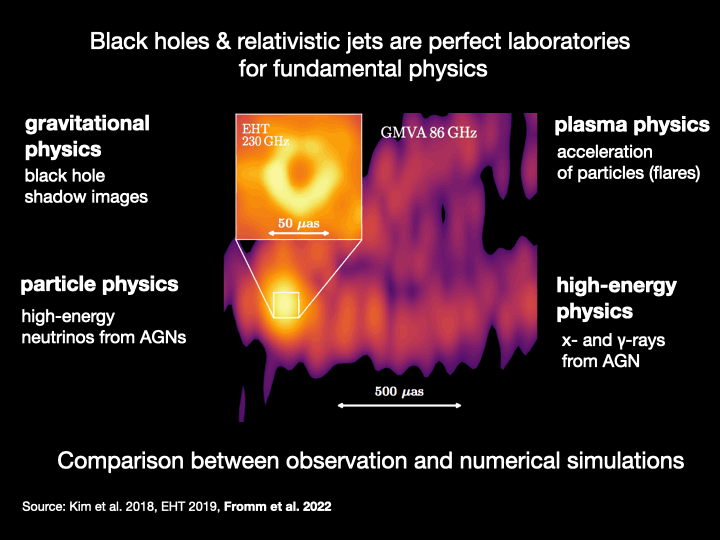
Our group consists of:
- Christian M. Fromm (group leader)
- Luca Ricci (Post-doc, also member of Kadler group)
- VLBI observations of relativistic jets
- synthetic data generation and image reconstruction
- radiative transfer calculation
- Ainara Saiz-Perez (PhD student)
- Numerical Jet Propagation simulations
- Radiative Transfer calculations
- Synthetic Data Generation
- Felix Glaser (MSc student)
- Numerical simulations of jet launching
- Polarised radiative transfer calculations
- Particle acceleration in jets
- Raoul Kinadeter (MSc student)
- Numerical simulation of galactic centre flares
- Polarised Radiative Transfer calculations
- Monte Carlo Radiative Transfer caculations
- Wladislaw Schulga (MSc student)
- Testing capabilities of future VLBI arrays
- Radiative Transfer calculations
- Synthetic data generation and imaging
- Eric Nanowski (MSc student)
- Numerical simulations of accreting black holes
- Radiative Transfer calculations
- Extracting accretion flow properties via optical flow techniques
- Florian Maul (BSc student)
- Radiative Transfer calculations
- Feature extraction (m-rings) from simulations
Former group member
- Yannik Hoche (MSc student, now PhD student University of Valencia)
- Roman Iotov (MSc student, now Deutsche Bundesbank, Frankfurt)
To study the dynamics of the magnetised plasma around black holes and the jet launching and propagation we perform 3D General Relativistic Magneto-Hydrodynamic (GRMHD) simulations. During the simulations we include electron thermodynaimcs i.e. the heating of electrons via magnetic reconnection as well as radiative cooling. In more recent simulations we include the effect of a physical resisitivity. For the jet propagation simulations we include realistic ambient medium conditions. Our simulations are performed with the BHAC and KHARMA codes which we modify and continously expand to our needs. Below we provide a 3D rendering of our simulations including jet launching from a rotating black hole and the propagation of the jet into the ambient medium. The magnetic field lines are shown in gray and in red. Notice the growth of different instabilities including kinks and Kelvin Helmholtz instabilities.
In order to compare our 3D simulations of accreting black holes and relativistic jets with observations across the electro-magnetic spectrum we perform radiative transfer (RT) calculations. During the RT calculations we include different electron distribution functions and evolve the radiating particles including sub-grid models inspired from kinetic particle-in-cell (PIC) simulations. Our main emission process is synchrotron radiation generated by relativistic electrons gyrating the magnetic field. However, we also include bremsstrahlung from the accretion disk and inverse compton scattering to compute the high energy emission i.e. X-rays and Gamma-rays. Below we show as example averaged images of MAD models for SgrA* and their broad band spectral energy distribution (SED).
For the direct comparison with observations especially with high-resolution VLBI observations it is necessary to generate synthetic data including the technical capabilities of the observing array, i.e. the limited coverage of the Fourier plane, the temperature of the receivers and the properties of the atmosphere i.e. the water vapor. In addition to the data generation, we also carry out image reconstruction using advance entropy based reconstruction algorithms. Our methods and tools can also be used to perform array optimisation studies (searching for the best suited locations of additional telescopes) or optimising the orbital parameters of space-based telescopes. Below we show the reconstruction of an M87-like object using the next generation VLA (ngVLA) in combination with telescopes in Germany at an observing frequency of 96 GHz.
We use of archival Very Long Baseline Interferometry (VLBI) observations black holes from the MOJAVE survey and the Boston Blazar Program. We re-analyse these observations by applying modern imaging algorithms extracting their spectro-polarimetric properties. The observations are accompanied by our black hole monitoring program TELAMON and future EHT observations of nearby SMBH systems as well as by newly proposed observations of candidate neutrino-associated accreting black hole systems. These evolving data sets form the observational foundation of our research and are used during the comparison with the developed numerical models. Given the complexity of the numerical simulations and synthetic data generation, a direct feed-back loop between the observational data and the numerical models is challenging. However, my developed \texttt{GENA} code based on non-gradient evolutionary algorithms (EAs) showed that it is possible to incorporate obserational data in the numerical modelling. Furthermore, we explore the capabilities of EAs and combine them with artificial neural networks and GANs i.e. generating black holes images via neural networks. Below we show a comparison between classical image reconstruction methods CLEAN) and maximum entropy based methods (MEM) for Mrk501 at 43 Ghz based on archival data from the Boston Blazar program.
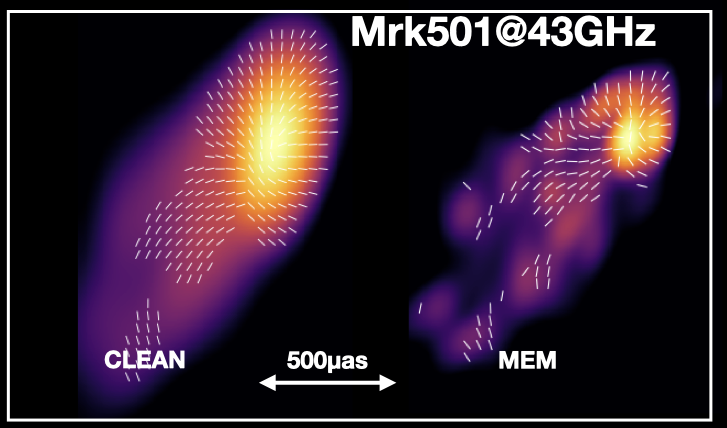
Our group is activley participating in the Event Horizon Telescope (EHT) Collaboration. We are working and contributing to the theory working group and contributed significantly to the modelling of the EHT observations of M87. More precise, we developed and run general relativistic magneto-hydrodynamical (GRMHD) simulations and radiative transfer (GRRT) calculations. Furthermore, we developed one of the modelling and feature extraction pipelines which obtained the mass of the central black hole in M87. For the modelling of the galactic centre SgrA*observations we performed besides the GRMHD and GRRT simulations, Monte-Carlo scattering simulations in order to obtain the broad-band spectrum of SgrA*.
Press releases
https://www.uni-wuerzburg.de/en/news-and-events/news/detail/news/erstes-bild-eines-unsichtbaren/
https://www.uni-wuerzburg.de/en/news-and-events/news/detail/news/shadowm87/
Within the DFG research unit "Relativistic jets in Active Galaxies", we lead the project on "Jet physics on horizon scales and beyond". Within this project we perform jet launching simulations and advanced radiative transfer calculations in order to model the observations of jets. In addition we build and maintain the local high-performance computing infrastructure at the chair of astronomy at the University of Wuerzburg. In this position we iterate the requirements of the local working groups and prepare the tenders for the hardware. Furthermore, we develop numerical methods for the analysis for radio observations and for the modelling of the spectral energy distribution (SED) of relativistic jets from the radio to the gamma-rays.
Press release
https://www.uni-wuerzburg.de/en/news-and-events/news/detail/news/jets-geben-viele-raetsel-auf-1/
Nowadays black holes are common features in public media, movies and science fiction. The latest results of the black holes in Messier 87 (M87) and the galactic centre of our Milky Way (SgrA⋆) increased the public interest on black holes even more.
However, how can the unseeable be made visible and being captured on an image? The physics behind black holes is typically mystified and many misleading concepts about the black hole images exist. At the Institute for Theoretical Physics and Astronomy at the Julius-Maximilians University Würzburg we combine in a unique way theoretical and observational studies of black holes. We developed SCHOLAR (Studing Black Holes in the Classroom) an outreach project of an interactive black hole visualisation toolkit to de-mystify black holes and allow pupils and interested citizens to explore the physics behind black holes. At the same time latest scientific results on black hole research is to the greater public. SCHOLAR can be run on tables and smartphones and is based on juypiter notebooks and python.


